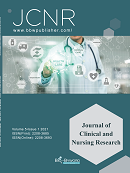Abstract
Objective: To investigate the efficacy and mechanism of ultra-early hyperbaric oxygen intervention in the treatment of diffuse axonal injury (DAI). Methods: Eighty-six patients with diffuse axonal injury were selected and then divided into an ultra-early hyperbaric oxygen treatment group and a conventional treatment group with 43 patients in each group. The Glasgow Coma Scale (GCS) on the 10th day (10d), 20th day (20d), and 30th day (30d) after treatment and the Glasgow Outcome Score (GOS) 6 months later were observed and compared between both the groups. Results: The average score of the GCS at 10d, 20d, and 30d as well as the GOS 6 months later in the ultra-early hyperbaric oxygen treatment group were higher than those in the conventional treatment group (P < 0.05). Conclusion: Hyperbaric oxygen therapy is one of the unique and effective methods in clinical treatment especially for the treatment of DAI patients and it is worthy of promotion.
References
Li G, Yuan S, Xiao W, et al., 2016, Early Hyperbaric Oxygen Treatment of 30 Patients with Diffuse Axonal Injury. Hainan Medicine, 27(2): 287-8.
Cui Y, Liu Z, Jiang S, et al., 2019, Efficacy of Hyperbaric Oxygen Combined with Gangliosides in the Treatment of Diffuse Axonal Injury and its Influence on Serum Related Indicators and Prognosis. Chinese Journal of Nautical Medicine and Hyperbaric Medicine, 26(5): 423-6.
Cardenas DP, Muir ER, Huang S, 2015, Functional MRI During Hyperbaric Oxygen: Effects of Oxygen on Neurovascular Coupling and Bold FMRI Signals. Neuroimage, 15(2): 212-3.
Hou G, Liu J, Wang C, et al., 2016, Quantitative EEG Relative Power Changes and Their Significance in Patients with Diffuse Axonal Injury Treated with Hyperbaric Oxygen at Different Pressures. Shandong Medicine, 56 (43): 79-81.
Yang Y, Zhang YG, Lin GA, et al., 2014, The Effects of Different Hyperbaric Oxygen Manipulations in Rats After Traumatic Brain Injury. Neurosci Lett, 563(5): 38-43.
Reynolds CA, Kallakuri S, Bagchi M, et al., 2011, Endothelin Receptor an Antagonism Reduces the Extent of Diffuse Axonal Injury in a Rodent Model of Traumatic Brain Injury. Neurolog Res, 33(2): 192-6.
Harch PG, 2015, Hyperbaric oxygen in chronic traumatic brain injury: Oxygen, pressure, and gene therapy. Med Gas Res, 14(1): 5.
Yang Y, Mei H, Liu J, et al., 2015, The Effect of Hyperbaric Oxygen Therapy at Different Pressures on the Prognosis of Severe Diffuse Axonal Injury. Chinese Journal of Nautical Medicine and Hyperbaric Medicine, 22(5): 378-81.
Dietrich WD, Bramlett HM, 2010, The Evidence for Hypothermia as A Neuroprotectant in Traumatic Brain Injury. Neurotherapeutics, 7(1): 43-50.
Zhou S, 2012, The Long-Term Effect of Hyperbaric Oxygen in the Treatment of Severe Head Injury. Jiangsu Medicine, 38(19): 2273-5.
Wu C, Wang L, Yao J, 2012, Early Hyperbaric Oxygen Treatment of 45 Cases of Diffuse Axonal Injury of the Brain. Chinese Journal of Trauma, 28(1): 40-2.
Gao C, Yang J, Zhai X, 2008, Basic and Clinical Medicine of Hyperbaric Oxygen, People’s Medical Publishing House, Beijing, 189.
Zhang Y, Wang X, Cheng P, 2015, Efficacy of Early Hyperbaric Oxygen in the Treatment of Diffuse Axonal Injury. Chinese Journal of Clinical Neurosurgery, 20(6): 366-7.
Yan X, Mo Y, Huo G, et al., 2017, Analysis of the Clinical Efficacy of Hyperbaric Oxygen in the Treatment of Diffuse Axonal Injury. Western Medicine, 29(2): 222-5, 229.
Li M, Wei J, et al., 2013, The Pathogenesis and Treatment Progress of Diffuse Axonal Injury. Chinese Medical Journal, 93(5): 397-9.
